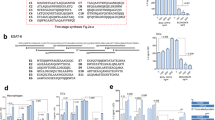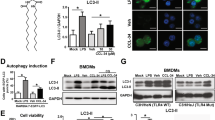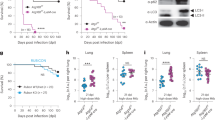Abstract
The variable efficacy of Bacille Calmette Guerin (BCG) vaccination against tuberculosis has prompted efforts to improve the vaccine. In this study, we used autophagy to enhance vaccine efficacy against tuberculosis in a mouse model. We examined the effect of autophagy on the processing of the immunodominant mycobacterial antigen Ag85B by antigen presenting cells (APCs), macrophages and dendritic cells (DCs). We found that rapamycin-induced autophagy enhanced Ag85B presentation by APCs infected with wild-type Mycobacterium tuberculosis H37Rv, H37Rv-derived ΔfbpA attenuated candidate vaccine or BCG. Furthermore, rapamycin enhanced localization of mycobacteria with autophagosomes and lysosomes. Rapamycin-enhanced antigen presentation was attenuated when autophagy was suppressed by 3-methyladenine or by small interfering RNA against beclin-1. Notably, mice immunized with rapamycin-treated DCs infected with either ΔfbpA or BCG showed enhanced T helper type 1–mediated protection when challenged with virulent Mycobacterium tuberculosis. Finally, overexpression of Ag85B in BCG induced autophagy in APCs and enhanced immunogenicity in mice, suggesting that vaccine efficacy can be enhanced by augmenting autophagy-mediated antigen presentation.
This is a preview of subscription content, access via your institution
Access options
Subscribe to this journal
Receive 12 print issues and online access
$209.00 per year
only $17.42 per issue
Buy this article
- Purchase on Springer Link
- Instant access to full article PDF
Prices may be subject to local taxes which are calculated during checkout






Similar content being viewed by others
Change history
07 July 2010
In the version of this article initially published online, Figure 1b was a copy of Figure 4b, and Figure 3d did not show all the correct bands. Both figures have been corrected for the PDF and HTML versions of this article. The legends and interpretation of the data remain the same.
References
Flynn, J.L. & Chan, J. Immunology of tuberculosis. Annu. Rev. Immunol. 19, 93–129 (2001).
Nathan, C. & Shiloh, M.U. Reactive oxygen and nitrogen intermediates in the relationship between mammalian hosts and microbial pathogens. Proc. Natl. Acad. Sci. USA 97, 8841–8848 (2000).
Miller, B.H. et al. Mycobacteria inhibit nitric oxide synthase recruitment to phagosomes during macrophage infection. Infect. Immun. 72, 2872–2878 (2004).
Vergne, I., Chua, J. & Deretic, V. Mycobacterium tuberculosis phagosome maturation arrest: selective targeting of PI3P-dependent membrane trafficking. Traffic 4, 600–606 (2003).
Rohde, K., Yates, R.M., Purdy, G.E. & Russell, D.G. Mycobacterium tuberculosis and the environment within the phagosome. Immunol. Rev. 219, 37–54 (2007).
Dean, R.T. Lysosomes and protein degradation. Acta Biol. Med. Ger. 36, 1815–1820 (1977).
Hmama, Z., Gabathuler, R., Jefferies, W.A., de Jong, G. & Reiner, N.E. Attenuation of HLA-DR expression by mononuclear phagocytes infected with Mycobacterium tuberculosis is related to intracellular sequestration of immature class II heterodimers. J. Immunol. 161, 4882–4893 (1998).
Noss, E.H., Harding, C.V. & Boom, W.H. Mycobacterium tuberculosis inhibits MHC class II antigen processing in murine bone marrow macrophages. Cell. Immunol. 201, 63–74 (2000).
Noss, E.H. et al. Toll-like receptor 2–dependent inhibition of macrophage class II MHC expression and antigen processing by 19-kDa lipoprotein of Mycobacterium tuberculosis. J. Immunol. 167, 910–918 (2001).
Pancholi, P., Mirza, A., Bhardwaj, N. & Steinman, R.M. Sequestration from immune CD4+ T cells of mycobacteria growing in human macrophages. Science 260, 984–986 (1993).
Harth, G., Lee, B.Y., Wang, J., Clemens, D.L. & Horwitz, M.A. Novel insights into the genetics, biochemistry, and immunocytochemistry of the 30-kilodalton major extracellular protein of Mycobacterium tuberculosis. Infect. Immun. 64, 3038–3047 (1996).
Singh, C.R. et al. Processing and presentation of a mycobacterial antigen 85B epitope by murine macrophages is dependent on the phagosomal acquisition of vacuolar proton ATPase and in situ activation of cathepsin D. J. Immunol. 177, 3250–3259 (2006).
Soualhine, H. et al. Mycobacterium bovis bacillus calmette-guerin secreting active cathepsin s stimulates expression of mature MHC class II molecules and antigen presentation in human macrophages. J. Immunol. 179, 5137–5145 (2007).
Katti, M.K. et al. The ΔfbpA mutant derived from Mycobacterium tuberculosis H37Rv has an enhanced susceptibility to intracellular antimicrobial oxidative mechanisms, undergoes limited phagosome maturation and activates macrophages and dendritic cells. Cell. Microbiol. 10, 1286–1303 (2008).
Schmid, D. & Munz, C. Innate and adaptive immunity through autophagy. Immunity 27, 11–21 (2007).
Schmid, D. & Munz, C. Immune surveillance via self digestion. Autophagy 3, 133–135 (2007).
Schmid, D., Pypaert, M. & Munz, C. Antigen-loading compartments for major histocompatibility complex class II molecules continuously receive input from autophagosomes. Immunity 26, 79–92 (2007).
Gutierrez, M.G. et al. Autophagy is a defense mechanism inhibiting BCG and Mycobacterium tuberculosis survival in infected macrophages. Cell 119, 753–766 (2004).
Amano, A., Nakagawa, I. & Yoshimori, T. Autophagy in innate immunity against intracellular bacteria. J. Biochem. 140, 161–166 (2006).
Xu, Y. et al. Toll-like receptor 4 is a sensor for autophagy associated with innate immunity. Immunity 27, 135–144 (2007).
Levine, B. & Deretic, V. Unveiling the roles of autophagy in innate and adaptive immunity. Nat. Rev. Immunol. 7, 767–777 (2007).
Skeiky, Y.A. & Sadoff, J.C. Advances in tuberculosis vaccine strategies. Nat. Rev. Microbiol. 4, 469–476 (2006).
Ramachandra, L., Noss, E., Boom, W.H. & Harding, C.V. Processing of Mycobacterium tuberculosis antigen 85B involves intraphagosomal formation of peptide–major histocompatibility complex II complexes and is inhibited by live bacilli that decrease phagosome maturation. J. Exp. Med. 194, 1421–1432 (2001).
Copenhaver, R.H. et al. A mutant of Mycobacterium tuberculosis H37Rv that lacks expression of antigen 85A is attenuated in mice but retains vaccinogenic potential. Infect. Immun. 72, 7084–7095 (2004).
Armitige, L.Y., Jagannath, C., Wanger, A.R. & Norris, S.J. Disruption of the genes encoding antigen 85A and antigen 85B of Mycobacterium tuberculosis H37Rv: effect on growth in culture and in macrophages. Infect. Immun. 68, 767–778 (2000).
Tanida, I., Minematsu-Ikeguchi, N., Ueno, T. & Kominami, E. Lysosomal turnover, but not a cellular level, of endogenous LC3 is a marker for autophagy. Autophagy 1, 84–91 (2005).
Ullrich, H.J., Beatty, W.L. & Russell, D.G. Interaction of Mycobacterium avium–containing phagosomes with the antigen presentation pathway. J. Immunol. 165, 6073–6080 (2000).
Horwitz, M.A., Harth, G., Dillon, B.J. & Maslesa-Galic, S. A novel live recombinant mycobacterial vaccine against bovine tuberculosis more potent than BCG. Vaccine 24, 1593–1600 (2006).
Moulton, R.A. et al. Complement C5a anaphylatoxin is an innate determinant of dendritic cell–induced TH1 immunity to Mycobacterium bovis BCG infection in mice. J. Leukoc. Biol. 82, 956–967 (2007).
Gupta, U.D., Katoch, V.M. & McMurray, D.N. Current status of TB vaccines. Vaccine 25, 3742–3751 (2007).
Levine, T.P. & Chain, B.M. The cell biology of antigen processing. Crit. Rev. Biochem. Mol. Biol. 26, 439–473 (1991).
Medd, P.G. & Chain, B.M. Protein degradation in MHC class II antigen presentation: opportunities for immunomodulation. Semin. Cell Dev. Biol. 11, 203–210 (2000).
Mazzaccaro, R.J. et al. Cytotoxic T lymphocytes in resistance to tuberculosis. Adv. Exp. Med. Biol. 452, 85–101 (1998).
Dhandayuthapani, S. et al. Green fluorescent protein as a marker for gene expression and cell biology of mycobacterial interactions with macrophages. Mol. Microbiol. 17, 901–912 (1995).
Am, A.O., Byrne, B.G. & Swanson, M.S. Macrophages rapidly transfer pathogens from lipid raft vacuoles to autophagosomes. Autophagy 1, 53–58 (2005).
Griffin, J.P. & Orme, I.M. Evolution of CD4 T cell subsets following infection of naive and memory immune mice with Mycobacterium tuberculosis. Infect. Immun. 62, 1683–1690 (1994).
Acknowledgements
This study was supported by US National Institutes of Health National Institute of Allergy and Infectious Diseases grant AI49534 (C.J.) and National Heart, Lung, and Blood Institute grant HL080205 (N.T.E.). We are grateful to L.Y. Armitige (University of Texas Health Sciences Center–Houston) for the fbpA and fbpB mutant strains, K. Rock (University of Massachusetts–Worcester) for the BMA.A3 cell line and C. Harding and H. Boom (Case Western Reserve University) for BB7 T cells. Recombinant ESAT-6 was kindly provided by A. Arora (Central Drug Research Institute, India), and TD17 mAb was a gift from K. Huygen (Pasteur Institute). Mycobacterial vector pMV206 was kindly provided by W. Jacobs (Albert Einstein Medical College).
Author information
Authors and Affiliations
Contributions
C.J. designed and performed the experiments with the technical assistance of D.R.L. S.D. prepared the overexpression strains of M. smegmatis and BCG. X.Y. and N.T.E. designed and produced RFP-LC3. C.J. and N.T.E. interpreted the data and wrote the manuscript. R.L.H. edited the manuscript.
Corresponding author
Supplementary information
Supplementary Text and Figures
Supplementary Figs. 1–7 (PDF 847 kb)
Rights and permissions
About this article
Cite this article
Jagannath, C., Lindsey, D., Dhandayuthapani, S. et al. Autophagy enhances the efficacy of BCG vaccine by increasing peptide presentation in mouse dendritic cells. Nat Med 15, 267–276 (2009). https://doi.org/10.1038/nm.1928
Received:
Accepted:
Published:
Issue Date:
DOI: https://doi.org/10.1038/nm.1928
This article is cited by
-
Next generation self-replicating RNA vectors for vaccines and immunotherapies
Cancer Gene Therapy (2023)
-
Reversing BCG-mediated autophagy inhibition and mycobacterial survival to improve vaccine efficacy
BMC Immunology (2022)
-
Re-engineered BCG overexpressing cyclic di-AMP augments trained immunity and exhibits improved efficacy against bladder cancer
Nature Communications (2022)
-
Human M1 macrophages express unique innate immune response genes after mycobacterial infection to defend against tuberculosis
Communications Biology (2022)
-
Modulation of the mTOR pathway plays a central role in dendritic cell functions after Echinococcus granulosus antigen recognition
Scientific Reports (2021)



